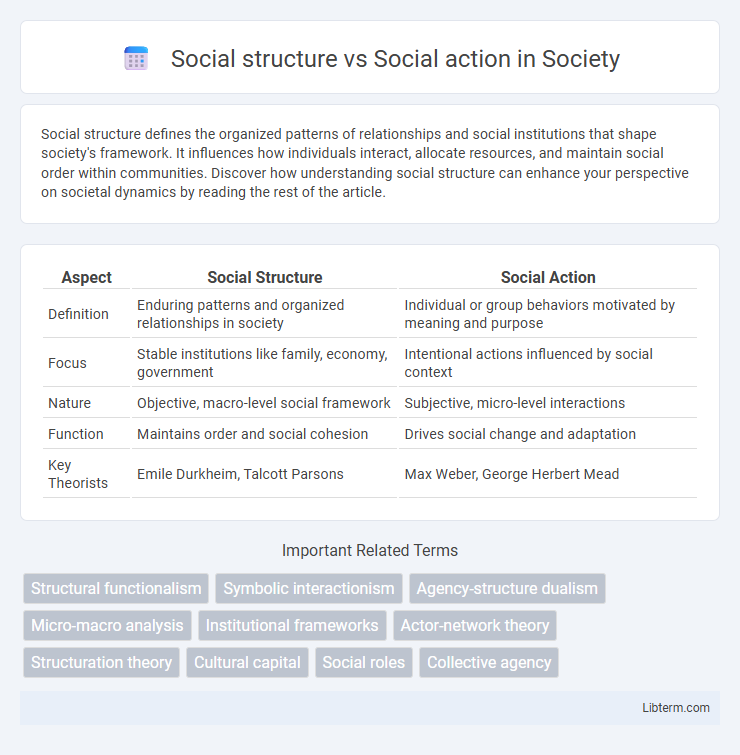Social structure defines the organized patterns of relationships and social institutions that shape society's framework. It influences how individuals interact, allocate resources, and maintain social order within communities. Discover how understanding social structure can enhance your perspective on societal dynamics by reading the rest of the article.
Table of Comparison
| Aspect | Social Structure | Social Action |
|---|---|---|
| Definition | Enduring patterns and organized relationships in society | Individual or group behaviors motivated by meaning and purpose |
| Focus | Stable institutions like family, economy, government | Intentional actions influenced by social context |
| Nature | Objective, macro-level social framework | Subjective, micro-level interactions |
| Function | Maintains order and social cohesion | Drives social change and adaptation |
| Key Theorists | Emile Durkheim, Talcott Parsons | Max Weber, George Herbert Mead |
Introduction to Social Structure and Social Action
Social structure refers to the organized pattern of social relationships and social institutions that together compose society, shaping individuals' roles and behaviors within a stable framework. Social action focuses on the meaningful and intentional behaviors of individuals as they interact and respond to their social environment. Understanding the interplay between social structure and social action is central to analyzing how societal norms influence individual activities and how collective behaviors can transform social systems.
Defining Social Structure: Foundations and Components
Social structure refers to the organized pattern of social relationships and institutions that together form the foundation of a society, influencing individual and group behaviors. Key components include social institutions (family, education, economy), social hierarchies, and roles that establish predictable interactions and social order. Defining social structure involves analyzing these interconnected elements that shape the framework within which social action occurs.
Understanding Social Action: Meaning and Types
Understanding social action involves analyzing individual or group behaviors directed toward achieving specific goals within a social context. Social action, as defined by sociologist Max Weber, includes four types: instrumental-rational action focused on efficiency, value-rational action driven by ethical beliefs, affective action influenced by emotions, and traditional action based on established customs. These types highlight how motives and contexts shape human behavior beyond the constraints of social structure, emphasizing agency in social interactions.
Key Theorists: Structuralism vs. Action Theory
Structuralism, prominently represented by Talcott Parsons, emphasizes the enduring frameworks and institutions that shape society's organization and individual roles within a social system. In contrast, Action Theory, championed by Max Weber and later developed by symbolic interactionists like George Herbert Mead, focuses on the meanings and intentions behind individual behaviors, highlighting agency and subjective interpretation. The debate between these perspectives centers on whether social structures determine action or if individual actions collectively constitute social reality.
Interaction Between Social Structure and Social Action
Social structure refers to the organized patterns of relationships and institutions that shape society, while social action involves individuals' behaviors motivated by meanings and intentions. The interaction between social structure and social action is dynamic; social structures influence individuals' choices and opportunities, yet these actions collectively reproduce or transform existing social systems. Understanding this interplay highlights how societal norms guide behavior and how human agency can initiate social change within established frameworks.
Impact on Individual Behavior and Society
Social structure provides the framework of institutions, roles, and norms that guide individual behavior by establishing predictable patterns and expectations, ensuring societal stability. Social action focuses on individuals' choices and interactions, emphasizing agency and the capacity to influence or change social structures through intentional behavior. The dynamic interplay between social structure and social action shapes societal evolution, where structural constraints impact personal behavior, and collective actions can transform social norms and institutions.
Social Structure: Constraints and Opportunities
Social structure shapes individual behavior by providing constraints such as norms, roles, and institutional frameworks that limit or guide social action. These constraints create predictable patterns of interaction and establish opportunities for social mobility, cooperation, or conflict within a society. Understanding the influence of social structure is crucial for analyzing how power dynamics and social hierarchies impact individual decision-making and collective outcomes.
Social Action: Agency and Change
Social action emphasizes individual agency, highlighting how personal choices and intentions drive social change within existing structures. It challenges deterministic views by showing that people actively interpret and reshape social norms, institutions, and relationships. Through the exercise of agency, social actors can transform power dynamics and initiate innovations in cultural and organizational frameworks.
Case Studies: Real-world Applications and Examples
Case studies of social structure versus social action reveal how institutional frameworks shape individual behavior and societal change. For example, Max Weber's analysis of bureaucracy illustrates how rigid social structures influence decision-making processes, while Emile Durkheim's study of suicide demonstrates how social cohesion affects personal actions. Contemporary research on social movements, such as the Civil Rights Movement, highlights the dynamic interplay where collective social action challenges existing structural inequalities.
Conclusion: Bridging Structure and Action in Sociology
Social structure provides the stable framework of institutions, norms, and roles that shape individual behavior, while social action emphasizes individual agency and intention within these contexts. Bridging structure and action reveals the dynamic interplay where structures both constrain and enable human actions, which in turn reproduce or transform social systems. Understanding this duality is crucial for analyzing social phenomena, as it highlights how individuals navigate and reshape the social world through meaningful practices embedded in structural conditions.
Social structure Infographic

 libterm.com
libterm.com